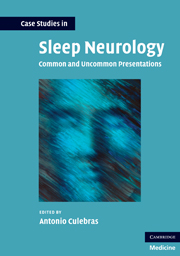Book contents
- Case Studies in Sleep Neurology
- Case Studies in Sleep Neurology
- Copyright page
- Dedication
- Contents
- ContentsThe following cases described herein have been published previously
- Foreword
- Contributors
- Abbreviations
- Introduction
- Part I Sleep-related breathing disorders
- Part II Hypersomnias of central origin
- Part III Circadian rhythm disorders
- Part IV Parasomnias
- Case 9 Extreme dreams
- Case 10 Odd sleep-related behaviors
- Case 11 Paralyzed and unable to breathe
- Case 12 Nightmares and numbness in the right arm
- Case 13 Screaming at night
- Case 14 Violent sleep behavior resulting in subdural hemorrhage
- Case 15 Amnestic nocturnal behavior
- Case 16 A terrified and terrifying scream
- Case 17 Frequent night-time wanderings
- Case 18 An adult sleepwalker who was sleep deprived
- Case 19 Seeking food in the night
- Case 20 The case of the missing loaf of bread
- Case 21 Gaining weight while asleep
- Case 22 Vivid images in the bedroom
- Case 23 Noisy breathing during sleep
- Case 24 Sexsomnia and obstructive sleep apnea
- Part V Sleep-related epilepsy
- Part VI Sleep and stroke
- Part VII Sleep-related movement disorders
- Part VIII Neuromuscular disorders and sleep
- Appendix: Epworth Sleepiness Scale
- Index
Case 19 - Seeking food in the night
from Part IV - Parasomnias
Published online by Cambridge University Press: 10 November 2010
- Case Studies in Sleep Neurology
- Case Studies in Sleep Neurology
- Copyright page
- Dedication
- Contents
- ContentsThe following cases described herein have been published previously
- Foreword
- Contributors
- Abbreviations
- Introduction
- Part I Sleep-related breathing disorders
- Part II Hypersomnias of central origin
- Part III Circadian rhythm disorders
- Part IV Parasomnias
- Case 9 Extreme dreams
- Case 10 Odd sleep-related behaviors
- Case 11 Paralyzed and unable to breathe
- Case 12 Nightmares and numbness in the right arm
- Case 13 Screaming at night
- Case 14 Violent sleep behavior resulting in subdural hemorrhage
- Case 15 Amnestic nocturnal behavior
- Case 16 A terrified and terrifying scream
- Case 17 Frequent night-time wanderings
- Case 18 An adult sleepwalker who was sleep deprived
- Case 19 Seeking food in the night
- Case 20 The case of the missing loaf of bread
- Case 21 Gaining weight while asleep
- Case 22 Vivid images in the bedroom
- Case 23 Noisy breathing during sleep
- Case 24 Sexsomnia and obstructive sleep apnea
- Part V Sleep-related epilepsy
- Part VI Sleep and stroke
- Part VII Sleep-related movement disorders
- Part VIII Neuromuscular disorders and sleep
- Appendix: Epworth Sleepiness Scale
- Index
Summary
Keywords
- Type
- Chapter
- Information
- Case Studies in Sleep NeurologyCommon and Uncommon Presentations, pp. 131 - 138Publisher: Cambridge University PressPrint publication year: 2010

